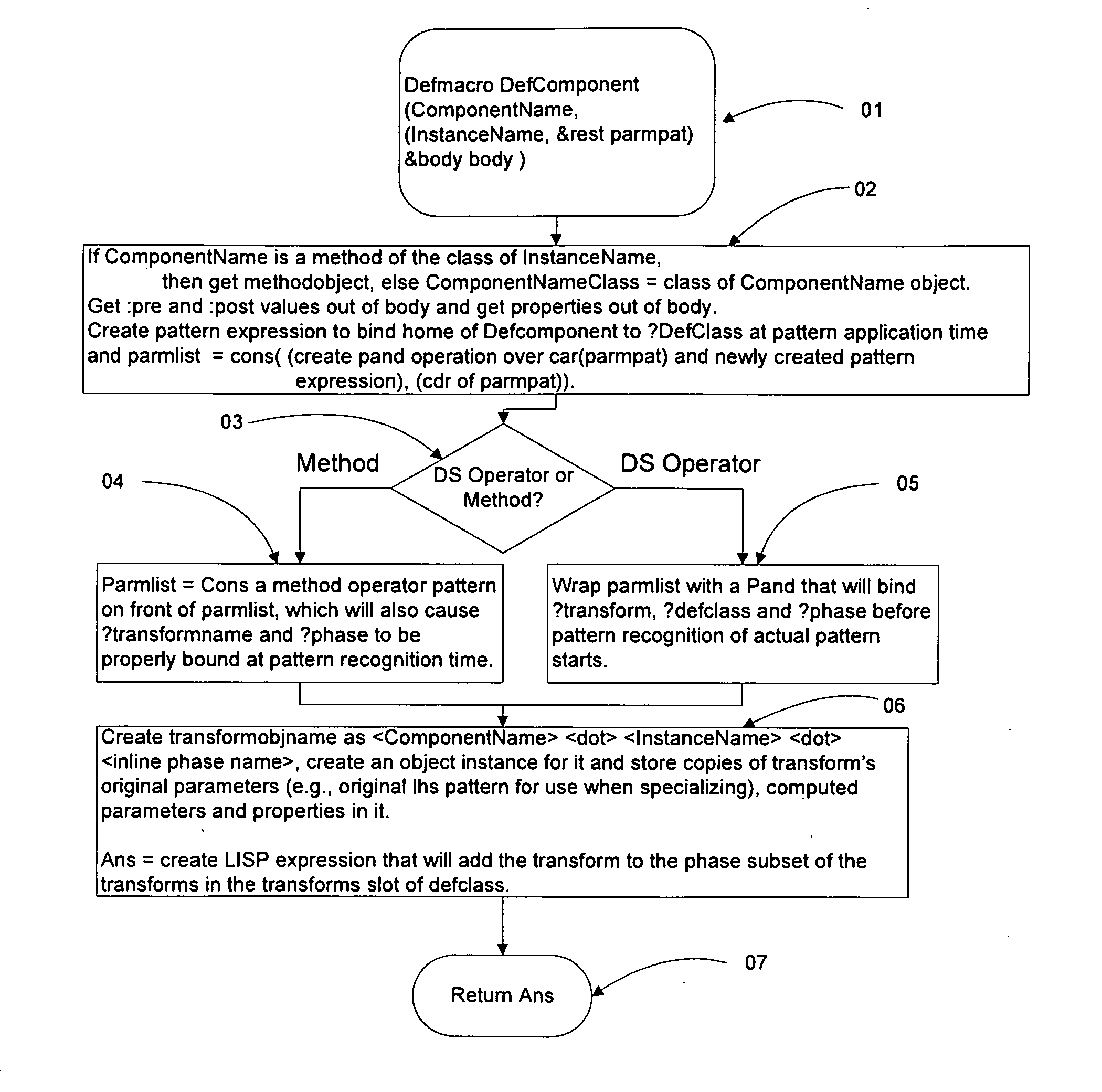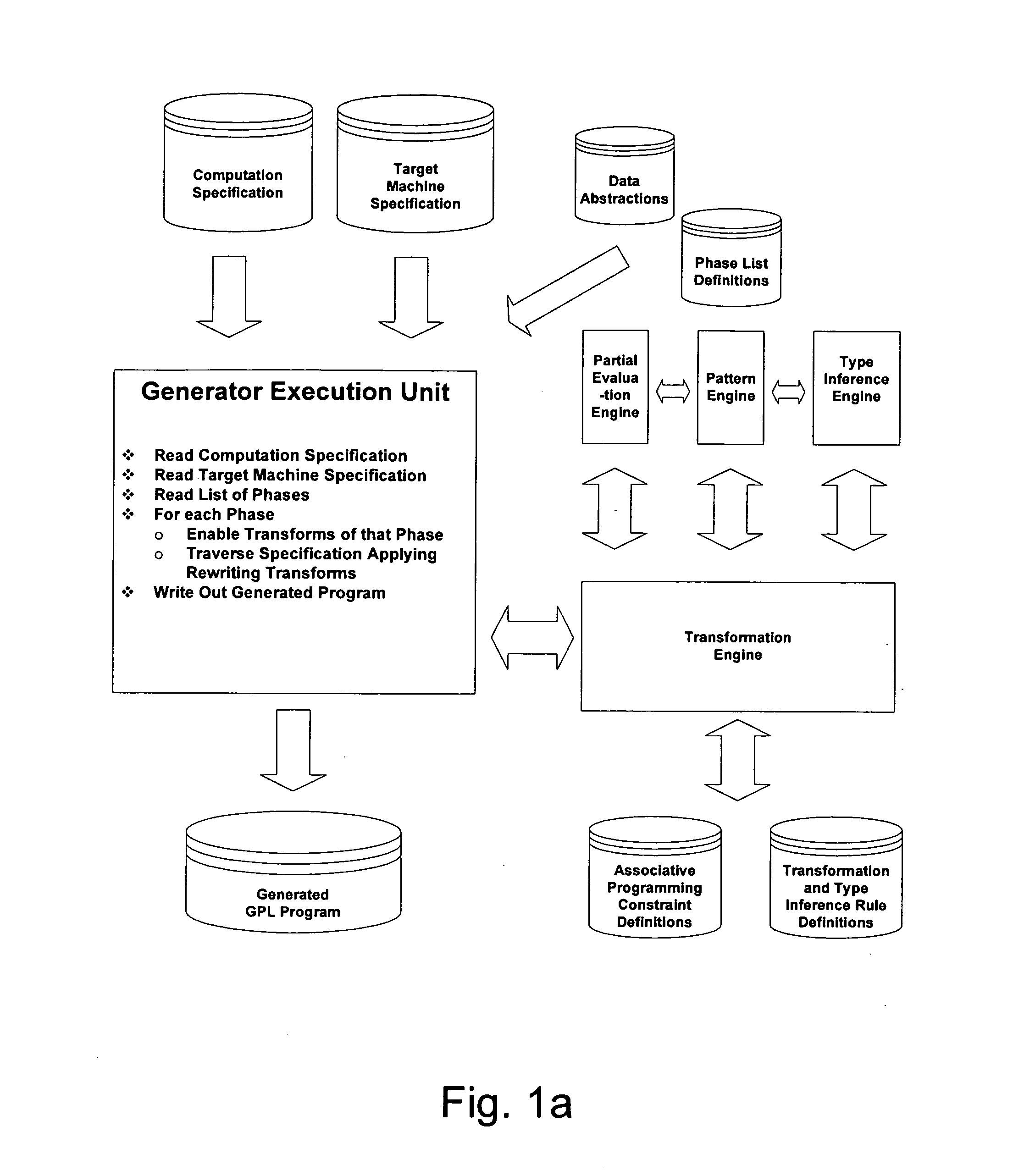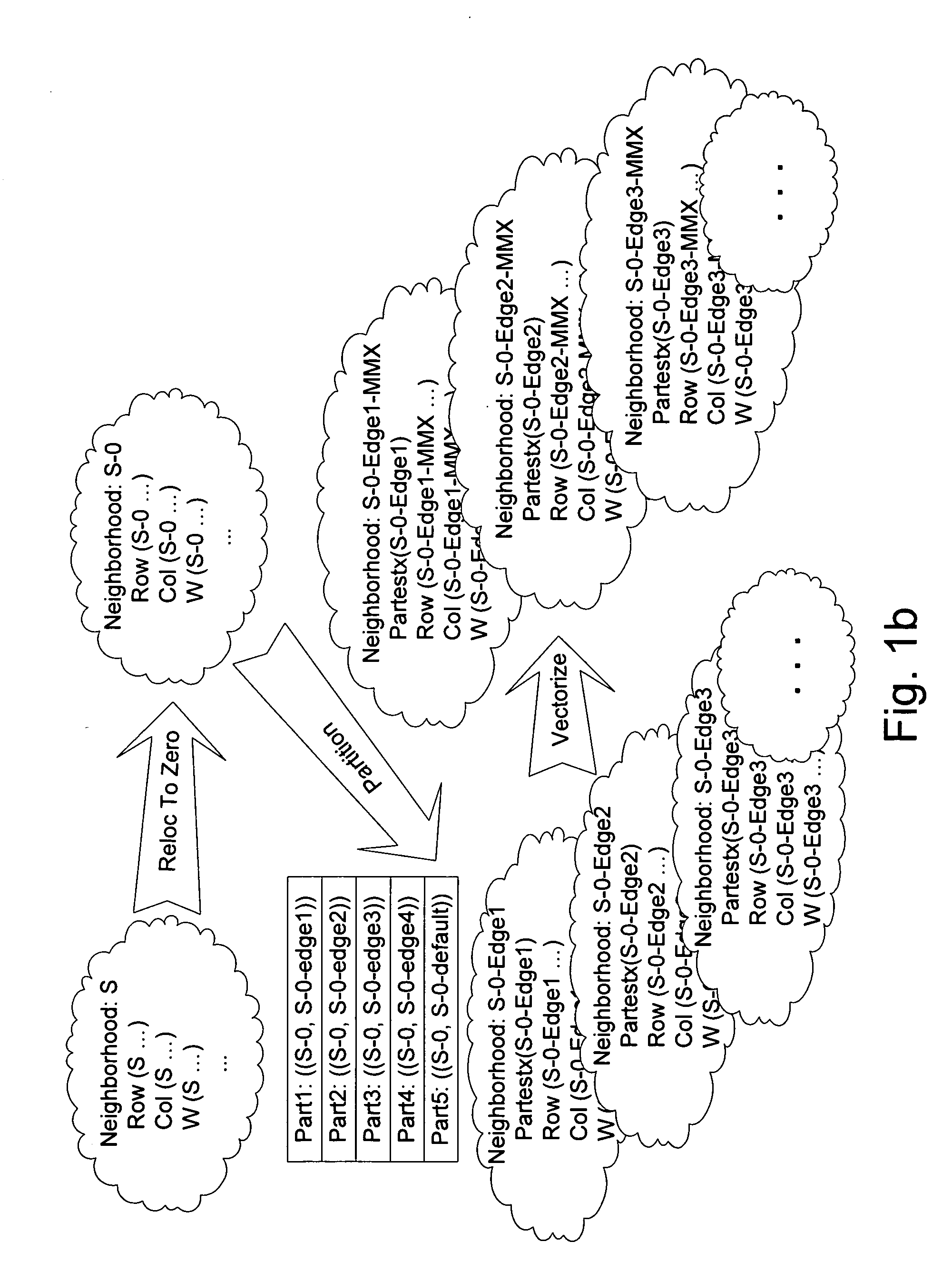: A well known drawback of new architectures for parallel machines is that in order to
exploit their parallelism, costly
reprogramming is usually required.
It is often too costly, complex, and
time consuming for companies and organizations to perform such conversions.
In many cases, this requirement has been the death knell of the parallel
machine or at least of the parallel elements of a
machine.
Prior approaches to
programming parallel machines are varied and all have significant problems and shortcomings.
However, these representations fall short in that they provide few or no mechanisms for exploiting the array of computational speed ups that are offered by the many new computational environments and machines.
Nevertheless, such opportunities for parallelism arise strictly out of the data structures in the
programming language and provide no method of discovering or taking
advantage of domain and
application specific opportunities for parallelism (e.g., problem or specific partitioning).
Furthermore, since any parallelization procedure / protocol for these languages is not operating in the “programming” domain (i.e., the domain whose focus is the process of designing and constructing a program), it does not have facilities for first formulating the broad-
brush target program architecture from (not-yet-concrete) design abstractions (e.g., partitions or thread partitions) unencumbered by low-level GPL details.
And as a consequence, it lacks the follow-on ability to add in the low level coding details as a separate step that reduces a big global coding problem to a set of smaller and largely independent or weakly dependent coding problems.
In short, because these languages are operating in the GPL domain, they are not suited to the principle of “design first, code later.”
The problem is that this approach does not really solve the partitioning and
reprogramming problem.
However, this is equivalent to giving up because the partitioning problem is just as hard (and most likely harder) within the
abstraction layer than it is within the application proper.
In all likelihood, the
abstraction layer will compromise full exploitation of theoretical performance increases possible through exploiting the
machine parallelism.
However, enhanced GPL approaches are a step backward in that, in addition to having all of the problems of GPLs (e.g., being difficult to manipulate by
automation), they have the additional problem of being tightly bound to the special features of their execution environment.
That is, they force commitment to detailed program structures too early (e.g., what data must be processed by what loops or iterations, how many different loops are required, what are the detail ranges of loops, how are loops broken up to exploit parallelism) and this precludes or complicates reorganizing the program to represent a different partitioning needed by a different parallel machine architecture.
In short, such approaches exacerbate the manipulation problem especially in the context of moving from one
computational environment to another that is architecturally quite different.
They are useful for programming a
single class of machine but antithetical to the objective of developing abstract program specifications that transcend the properties of any particular machine architecture.
In the previous research, that ideal has not been fully accomplished.
The approach is limited by the fact that both representations—the GPL language and the OpenMP directives—are dealing with low level concrete details.
A deeper problem may be that the
programmer is given two hard, detailed tasks: 1) write the computation in a GPL and then, based on a limited understanding of what the
compiler can and will do, 2) describe to it how to parallelize these locales (e.g., partition a computation into threads).
Further, the
programmer is likely to be somewhat in the dark on the exact nature of the generated code, which makes adding the successful directives even harder.
Additionally, it is not particularly useful for parallelization opportunities that do not lend themselves to thread-based parallelism.
Whenever a new parallel architecture appears, the old directives are pretty much useless.
However, while the AOG approach can be an improvement over
fully automatic compiler parallelization because it can realize partitionings that avoid the high overhead problem of lots of little partitions, it too has flaws that result from the optimization processes having to operate on a
programming language representation of the code (i.e., a too detailed representation).
Occasions arise where intervening code is generated that prevents the automatic distribution of the two loops thereby preventing the merging of the “if tests”, which in turn prevents the ideal partitioning.
The deeper problem is waiting until code is generated with all of its detailed variations.
While the code level representational approach makes expressing partition details easier because they are expressible in well known
programming language terms (e.g., array index expressions), it makes recognizing the code more difficult and is fraught with unforeseen opportunities for failure.
However, until this invention, it was not known how to automate this process.
(See Bacon et al 1994) Unfortunately, the amount of parallelization achievable with code optimization appears to be limited to rather simple cases in which the code has certain desirable properties and determining the existence of those properties is feasible.
Unfortunately, only a portion of the opportunities for optimization can be detected because many opportunities are beyond the ability of the analysis process.
(See Hall et al15, 2005) The process often finds many little, separate opportunities rather than a larger, combined opportunity, which increases the computational overhead costs and thereby reduces the speed ups of parallelization.
Finally, the optimization process is generally unable to take
advantage of domain
specific knowledge that can easily identify the large opportunities for parallelization and it is this latter point that places the hard limits on the degree to which
compiler optimization can exploit opportunities for parallelism.
However, there has always been one major but largely unrecognized stumbling block—the representation of the target program.
Because the target program is usually specified in a GPL form, the concrete level details of the GPL make the
rewriting process excessively complex and introduce many ways for that
rewriting process to fail.
In general, transformations of the target program representation often require knowing complex program properties that are difficult or infeasible to derive from the GPL code (much like with compiler optimization).
While AOG makes some progress with these difficulties by using the
domain knowledge encoded in the tags to guide the overall process, the many detailed, GPL-induced constraints within the target program can make the addition of new variations to the process difficult.
Fundamentally, the author believes that the key problem with all of these approaches is that the manipulation is done in the code or GPL domain (as opposed to the
problem domain) and many of the complex properties that are so difficult to determine arise from the imperative nature and the low level detail of the GPL language itself.
In other words, a GPL program representation is not sufficiently domain oriented and the GPL technologies for abstraction (e.g., Object Oriented representations) are insufficient to make the difficult property inferences disappear.
In short, a GPL representation is too imperative and not declarative enough.
It is too much oriented to programming machines and too little oriented to describing domain or problem solutions.
That is, pick a problem that is easily programmed on certain parallel machines.
For example, some problems, like
weather simulation, allow a full program to be replicated on many machines and run in parallel.
Unfortunately, most problems that can benefit from parallel execution are not in this class and therefore, not amenable to this approach.
This still leaves the general partition problem unsolved for most programs.
All the potential benefits of parallelization and computational speed up are lost.
In terms of the market and business pressures, this just is not an option!
Of course, this metaphor of drawing to specify a computation is limited to those problems whose domains have a large geometric component.
Unfortunately, beyond UI problems, the majority of problems that can profit significantly from parallelism do not have this property.
Preliminary Conclusion on Prior Art: The failure of the large amount of prior art work over the last thirty years or so is strong evidence that the problem is unsolved in any broad, practical sense and certainly, that a practical solution is not obvious.
Unfortunately, those research promises too (as they apply to the parallelization of computations) are largely unfulfilled.
A common shortcoming of all of these systems is that they do not solve the problem of constraints that affect separated areas of the target program (i.e., cross program
constraint satisfaction).
Systems based on the paradigm of local substitution cannot accomplish this task of cross-program
constraint satisfaction.
And importantly, automatic partitioning and generation from a machine architecture free, implementation neutral specification of a computation is not within the grasp of these paradigms.
As with earlier approaches, the fundamental problem with these approaches is that they are dealing with representations within the GPL domain (lightly abstracted) and therefore, they suffer many of the same problems discussed earlier.
This complicated the job immensely.
Further, the heavy use of informal information in these steps precludes them from being directly or fully cast into automated form.
In that sense, these approaches suffer from the GPL mindset in that the formal specifications are at a very detailed and concrete level, a very GPL level.
However, explicit associative programming constraints (i.e., APCs) expressed in domain-specific terms that guide the program construction and optimization rewrites is an idea that is absent from the literature.
But apart from Neighbors work, this author's work, and a few others, there is a relative
small footprint for domain specific generation of the variety that so clearly eschews GPL representations as the basis for DSLs.
The general domain-specific generation topic is growing and there is lots of interest in it, but the
footprint of concrete results without the GPL slant is still small.
On the other hand, conceiving of how one might approach parallelization in a non-GPL but strictly domain specific context is quite difficult.
Some (but not all) of these questions are answered easily given the concrete terms of GPL structures even though turning those easy answers into a highly parallel program is hard and the results are limited27.
Consider the following quote from a recent paper28 “Domain-specific analysis,
verification, optimization, parallelization, and transformation of application programs written in a GPL are usually not feasible because the
source code patterns involved are too complex .
It is easier to get started and even to get some limited results with that approach than with the alternative, which may not yield anything for years, if ever.
This is a research struggle that has resulted in either research-oriented, toy solutions that cannot be scaled up to deal with real world programming problems or niche solutions that fall into one of the several (unsatisfactory) solution categories discussed above.
The problem of programming parallel machines is significant enough that one can find many books and tutorials devoted to parallelizing algorithms for various parallel machine architectures as well as systems and tutorials aimed at programmers for such machines.
Because of this evolution, the problem of how to program these chips is becoming more acute.
Software consultants from
Silicon Valley have recently reported numbers of
back channel inquiries about solutions to the problem of programming multicore chips, a clear indication that the current solutions are inadequate.
Lots of solutions have been proposed none of which have vaulted
parallel computing into the main
stream of computing.Speculation within PC
specialty magazines (for example) about what kind of applications would benefit from multicore machine and whether or not they will ever be implement on multicore machines because of the programming difficulties.
The lack of identifiable general, domain-based parallelization solutions after thirty plus years of trying is strong evidence that this general problem has not yielded to the huge amounts of effort aimed at it.
In the end, the
market place is filled with parallel programming languages, libraries, specialized development environments, tools to aid programmers and more, but all are tied to specific architectures or provide inadequately general solutions.
The failure of research to produce adequate solutions to and products for the
automatic parallelization of computations for a variety of parallel architectures even in the face of intense market pressure is strong evidence of the underlying difficulty and non-obviousness of the problem.
Partitioning by Design Rather than by Renovation: Much like fundamentally changing the structure of a house after it is built, renovating a program for parallel execution after it is implemented in a GPL (or even a parallel GPL) is difficult and often impossible.
The
generation process is unrestricted by the difficulties of analyzing complex programming language implementations.
This is a complex process and often cannot completely capture the properties via analysis.
Hence, automated analysis may only identify a portion of the opportunities for parallelization.
While it is sometimes difficult to discover how to use DSLs and
Prior art in domain specific program generation has created inspiring models (e.g.,
Finite State Models of communication protocols) but has not addressed the problem of reorganizing (i.e., partitioning) computations for parallel computation.
In general, domain specific program generation models to date have not performed major design-driven reorganizations (and particularly, no machine-architecture-driven reorganizations) of the target program design.
That is, the prior art has not invented machinery to automatically break the
programming process into two separate but related parts and thereby simplify the overall process, while still retaining
fully automated generation.
 Login to View More
Login to View More  Login to View More
Login to View More 


